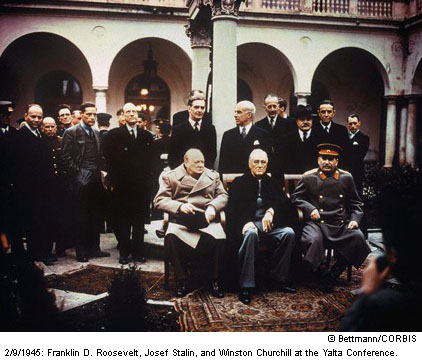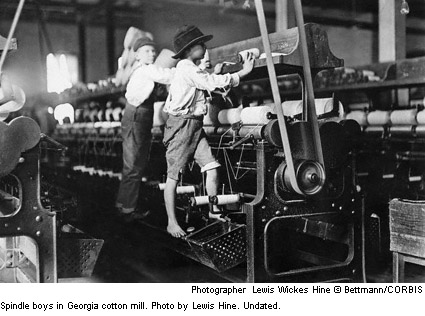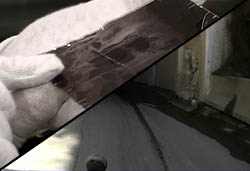|
A Visit to the Corbis Picture
Mine
June 2003
A Special Report by Dirck Halstead |
 It
was heart breaking. It
was heart breaking.
Ken Johnston loved photographs and photojournalism. For two decades
he had been a researcher for the Bettman archives, one of the largest
collections of photography in the world. In the late 1980s, Bettmann
bought the United Press International archives, and in 1995, Corbis,
the giant corporation privately held by billionaire Bill Gates bought
the entire collection.
For Johnston the problem was that his beloved collection was rapidly
dying. Of the 11,000,000 plus negatives, plates and prints stored in
manila folders on shelves in Bettmann's Manhattan office, many were
turning to vinegar.
The smell permeated the entire floor that Bettmann occupied. Employees
would start to gag as they retrieved priceless photographs for clients.
And worst of all, the negatives would crumble into dust as they were
removed from their envelopes.
This collection represents a vast proportion of the world's visual legacy.
And it was vanishing before Johnston's eyes.
The root of the problem is that photographs are inherently unstable.
Many photographers are painfully aware that color negatives, prints,
and transparencies have a relatively short life span. The dyes in color
reversal film introduced in the 1950s are especially vulnerable to fading
following exposure to sunlight. But serious photographers take comfort
that black and white film has survived for as much as a century, and
in most cases outlives the photographer. What they did not realize was
that some insidious chemical reactions were taking place which would
eventually destroy even the best cared for prints and negatives.
Negatives are comprised of two layers of materials--the base and the
emulsion. Cellulose acetate, a plastic that decays, creating acetic
acid, or vinegar has been used as a base. The light-sensitive emulsion
glued to the top of cellulose acetate is very stable. But as the base
decays, the emulsion starts to break away from it, bubbling up and contracting.
Heat and humidity accelerate the deterioration. Once the process gets
to this point, the photograph is rendered unusable and cannot be saved.
As the bulk of the collection at Bettmann aged, the process started
spreading like a plague throughout the shelves. In particular, the acetate
based negatives from the 1930s and 1950s, were decomposing fastest.
 Photographic archiving expert Henry Willhelm was hired by Bill Gates
to see if something could possibly be done to at least slow down the
process. In a 21-page report Willhelm recommended that the collection
be put in cold storage. Specifically, the room temperature surrounding
the photographs needed to decreased to the sub-zero range. Willhelm
was aware of the effects that cold had on a wooly mammoth that had stumbled
into a pre-historic ravine, and essentially was frozen before decay
could start. Thousands of years later the beast was still intact, complete
with its fur.
Photographic archiving expert Henry Willhelm was hired by Bill Gates
to see if something could possibly be done to at least slow down the
process. In a 21-page report Willhelm recommended that the collection
be put in cold storage. Specifically, the room temperature surrounding
the photographs needed to decreased to the sub-zero range. Willhelm
was aware of the effects that cold had on a wooly mammoth that had stumbled
into a pre-historic ravine, and essentially was frozen before decay
could start. Thousands of years later the beast was still intact, complete
with its fur.
But how would you refrigerate an area that held 11,000,000 photographs?
The answer it turned out was in an abandoned limestone mine near Butler,
Pennsylvania. There were almost a million square feet of tunnels more
than 200 feet below the Appalachian forest. In the 1960s the government
had started moving critical information into the mine. The property
was acquired by a company called Iron Mountain, which started to provide
vault space to the Defense Department, the National Archives, major
corporations, film studios. Gates decided that was answer.
So in late 2001, nineteen trucks moved the collection from Manhattan
to the mine.
When Corbis announced the plan, far from being hailed as the savior
of photographic history, Gates was pilloried by the press, photographers,
and researchers. The New York Times' Sarah Boxer wrote in a front page
story, " The Bettmann archive, the quirky cache of pictures that
Otto Bettmann sneaked out of Nazi Germany in two steamer trunks in 1935
and then built into an enormous collection of historical importance,
will be sunk 220 feet down in a limestone mine situated 60 miles northeast
of Pittsburgh, where it will be far from the reach of historians."
The Digital Journalist was just one of many other voices that in columns
and editorials lambasted Corbis and Gates for removing accessibility
to this great collection, and thus limiting choice for publications.
 Gates
did not help his image much during this period. Most of the move was
done secretively. The entrance to the mine itself, complete with heavy
iron gates and armed guards looked like some foreboding high security
installation from the cold war. To Bettman's former clients, it appeared
that they were being locked out. Gates
did not help his image much during this period. Most of the move was
done secretively. The entrance to the mine itself, complete with heavy
iron gates and armed guards looked like some foreboding high security
installation from the cold war. To Bettman's former clients, it appeared
that they were being locked out.
So, it was with some surprise, especially after writing a commentary
for The Digital Journalist that baldly stated that Bill Gates was responsible
for the biggest change in the health of the photography industry in
25 years, that I received an invitation from Corbis' Vice President
of News and Editorial Photography, Brian Storm,, to join a small group
of photographers and editors to travel to the mine and spend a weekend
helping to research and edit photographs for a new book commemorating
Otto Bettmann's 100th Birthday.
On a beautiful spring day, we faced the huge iron gate that rolls up
into the mouth of the cave. After being briefed and issued fire extinguishers,
our small company was driven deep into the mine. 200 feet below the
earth, powered by their own generators, mercury lights provided an eerie
glow as we drove past red doors inserted into the rock wall. We were
cautioned not to photograph them, because many of the clients that Iron
Mountain provides services for do not want it known that their archives
and vital records are stored there.
About a mile into the cavern, we turned a corner, to see two small palm
trees and a plasma screen next to a door displaying the gray logo, Corbis.
The plasma screen on the wall displays a continuing series of some of
the world's greatest photographs, which represent the visual history
of the past century.
Inside the door, is a long room dominated by editing tables and light
boxes. It is here that researchers can spend hours, days, or weeks,
looking through the collection. White-gloved employees bring in carts
stacked high with folders filled with pictures.
 This is one of the first things that began to change my opinion about
the purpose of the mine. I had envisioned all these pictures being locked
into cold storage, away from the eyes of people who wanted to search
this knowledge base. In fact, the opposite was true. As any one who
has tried to do major research in the New York office will attest, the
process was not easy. There was limited desk space, and a flurry of
coming and going which was not conducive to the sometimes lengthy hunt
for photographs. Here, there seemed to be all the time in the world,
with no distractions. True, you must go to Western Pennsylvania to do
it, but for serious researchers this is not a huge problem.
This is one of the first things that began to change my opinion about
the purpose of the mine. I had envisioned all these pictures being locked
into cold storage, away from the eyes of people who wanted to search
this knowledge base. In fact, the opposite was true. As any one who
has tried to do major research in the New York office will attest, the
process was not easy. There was limited desk space, and a flurry of
coming and going which was not conducive to the sometimes lengthy hunt
for photographs. Here, there seemed to be all the time in the world,
with no distractions. True, you must go to Western Pennsylvania to do
it, but for serious researchers this is not a huge problem.
In the meantime, Corbis continues to scan photographs from the collection.
It is not a cheap endeavor. It costs about $70 per image to make the
high definition scans required, including captioning, photo shop, and
research. Corbis encourages researchers to come to the mine. As the
clients find photographs, the staff takes note, and if the photos ordered
have not been scanned, that will be done as soon as possible. It is
using intellectual karate to improve the collection's online resources.
Searches can also be instigated from New York, or cities around the
world.
Although the temperature of the vast vault which lies behind the editing
room is capable of being lowered to the zero degree level recommended
by Willhelm, it will be kept at a level of 44 degrees for the next few
years. This enables bundled-up researchers to spend the time they need
in the archives.
 To enter the vault from the edit space you must go through a pressure
chamber. Once visitors are inside the pressure chamber, the outer door
closes and the temperature and humidity are stabilized before the door
into the vault swings open.
To enter the vault from the edit space you must go through a pressure
chamber. Once visitors are inside the pressure chamber, the outer door
closes and the temperature and humidity are stabilized before the door
into the vault swings open.
The vault itself stretches for hundreds of feet into the limestone room.
There are long rows of filing cabinets that contain millions of envelopes
of photographs, with captions. Glass plates are carefully boxed, but
available. The employees, many of whom have worked at Bettmann for years,
know exactly where the treasures are located.
Opening a drawer containing International News Photos images from the
1930s, the smell of vinegar suddenly emanates. For Ken Johnston, who
is now the manager of Historical Collections, the satisfaction comes
from knowing that the aging process in now being dramatically arrested.
One of the big jobs facing Johnston and his colleagues is to identify
the photographers who took the photographs. The filing systems of INP,
ACME, and United Press, generally did not put the names of their staff
photographers on the captions. The Corbis staff is trying to decipher
the initials used on the captions to discover who the photographer was.
They also encourage users who go to the Corbis web site to give them
further information about the photographers who took the pictures.
During our two days in the mine, we all had projects that we wanted
to research. I wanted to see the ENTIRE Vietnam War collection. Well,
not quite the entire collection, since that was nearly a million images
on its own, but at least all the prints made at the time, which were
the selects made by the editors of UPI. I was one of them, as the picture
bureau manager in Saigon in 1965-1966. For the next three hours, staff
brought out cart after cart, more than 4,800 images, which I went through
one by one. Some of them, such as the picture by Kyoichi Sawada which
won the Pulitzer Prize in 1966, of a Vietnamese family swimming across
a river to escape a battle, I knew about. But as I went through the
pictures, I realized that I was amassing a major portfolio by a photographer
who I had totally forgotten about.
 The
Corbis people were surprised as I laid out a story by Shunske Akaatsuka
about the battle for Hamburger Hill. It was one of the strongest portfolios
of combat photography I had ever seen. It had been sleeping, unnoticed
in the archives for the past 35 years. The
Corbis people were surprised as I laid out a story by Shunske Akaatsuka
about the battle for Hamburger Hill. It was one of the strongest portfolios
of combat photography I had ever seen. It had been sleeping, unnoticed
in the archives for the past 35 years.
It is just this sort of thing that encourages me. As Corbis allows more
and more photographers, editors, and academics into this room 200 feet
below ground, our visual legacy will be enriched, and most important,
preserved for the generations to come.
© Dirck Halstead
dhalstead@dvnetwork.net
|

